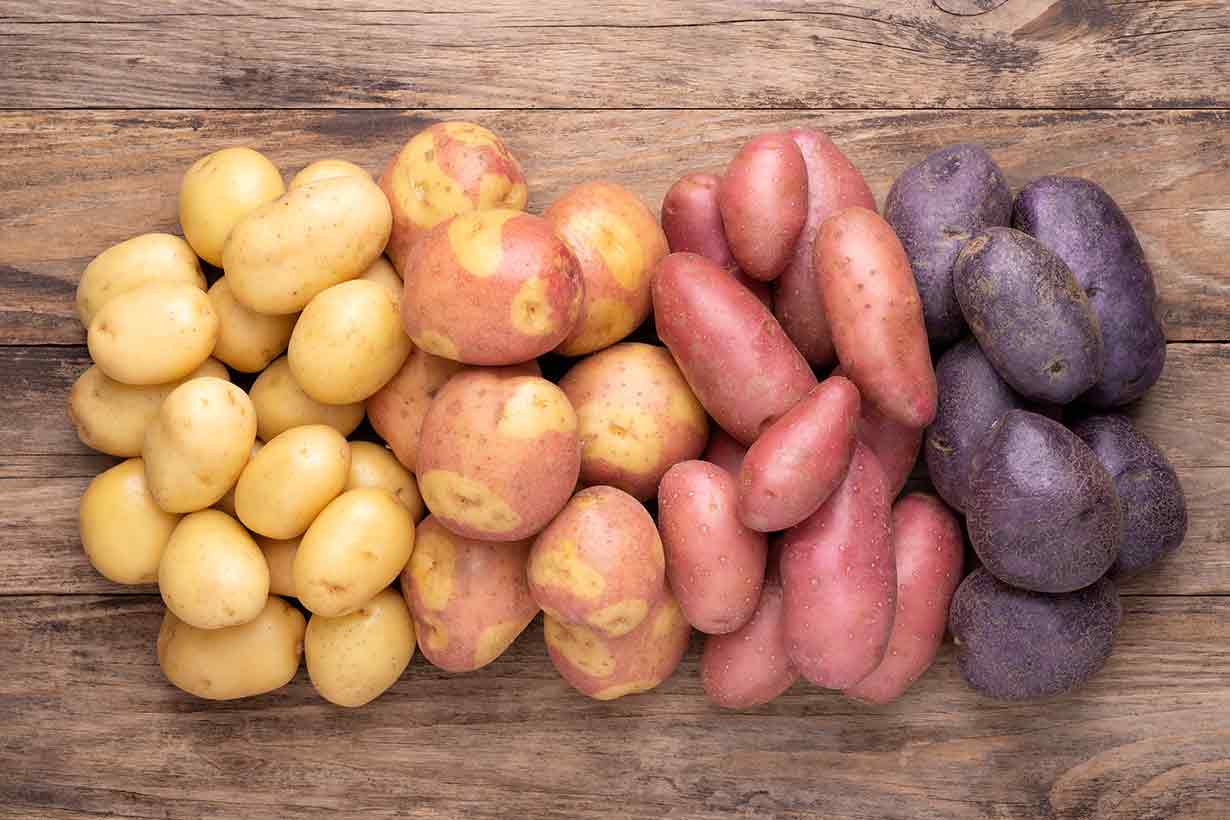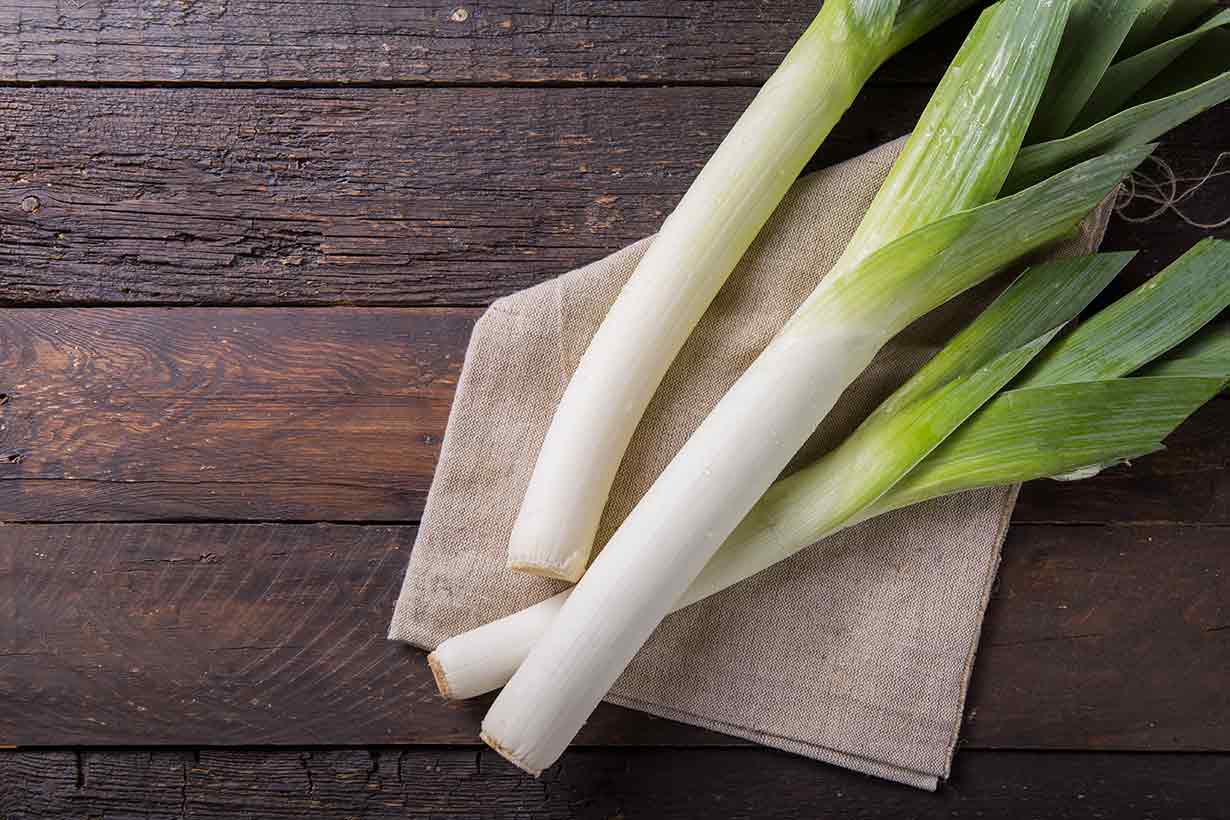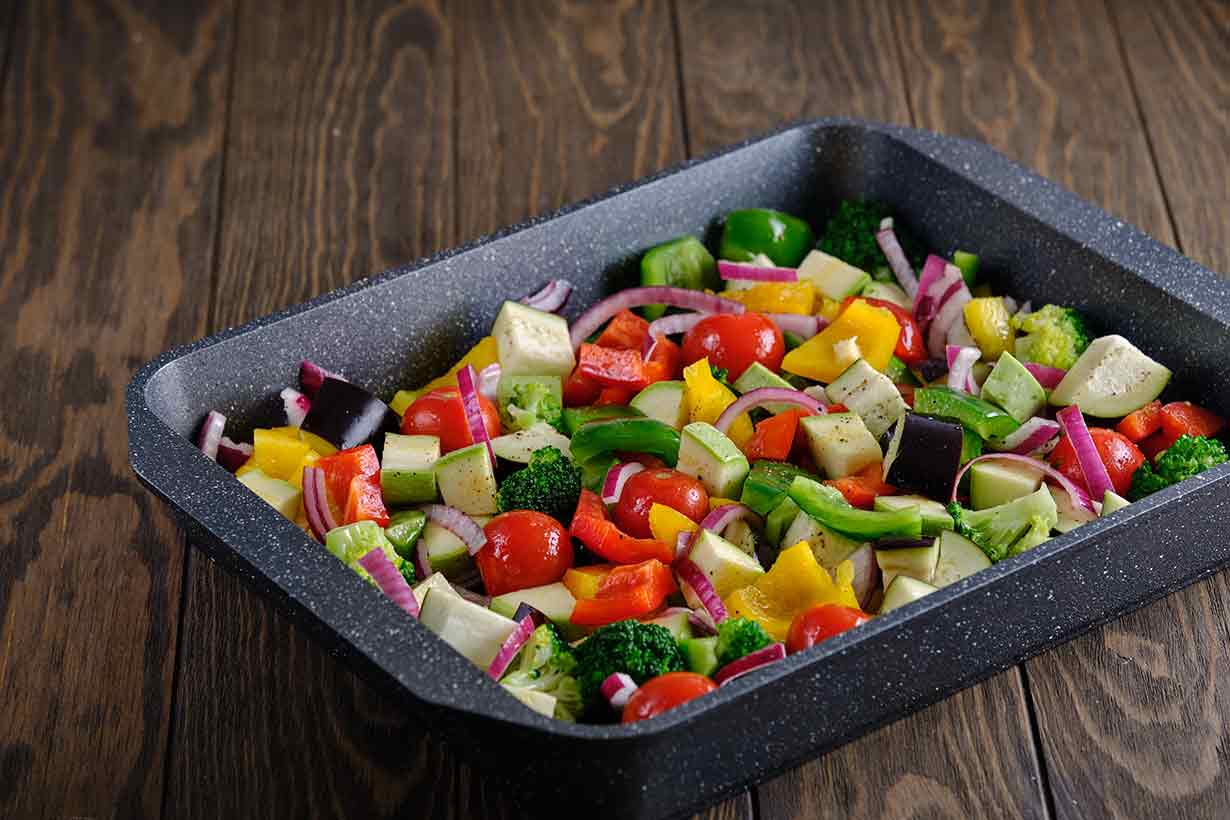The unique taste profiles of allium vegetables enhance the taste of a wide range of dishes.
Moreover, vegetables belonging to the allium family may offer some potential health benefits.
This article delves into the potential health benefits of allium vegetables.
Furthermore, we provide a list of common allium vegetables, along with their characteristics, nutrition facts, and suggestions for culinary use.
Table of contents
What Are Allium Vegetables?
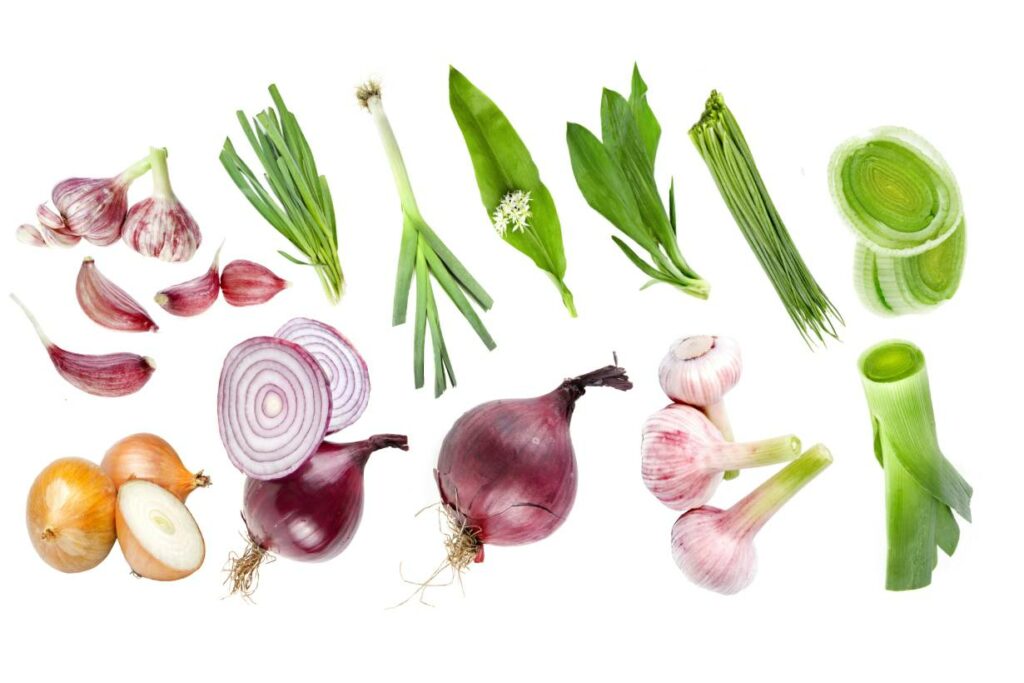
Allium vegetables belong to a family of vegetables that come from the Allium genus of plants.
In fact, there are over 600 different allium plants. However, only a handful of them are typically consumed as part of human diets (1).
These edible allium vegetables include:
- Chives
- Garlic
- Leeks
- Onions
- Rakkyo
- Scallions (also known as ‘green onions’ and ‘spring onions’)
- Shallots
Vegetables in the allium family boast an interesting range of compounds thought to offer health benefits. These compounds encompass fiber, polyphenols, sulfur and organosulfur compounds, as well as a broad range of vitamins and minerals (2).
In terms of their nutritional properties, allium vegetables tend to be relatively low in calories. They primarily provide carbohydrates, including a notable fiber content, and are generally a good source of vitamin C and a range of minerals (3).
Organosulfur Compounds
One of the standout benefits of allium vegetables is their high content of organosulfur compounds.
Organosulfur compounds are essentially organic compounds that contain sulfur atoms. These compounds frequently have a pungent aroma, accounting for the potent smell of vegetables like garlic and onions (4).
Research into organosulfur compounds has demonstrated their potential for a variety of beneficial properties, including:
- Antibacterial properties: Numerous studies have demonstrated the antimicrobial properties of organosulfur compounds (5, 6, 7).
- Anticancer properties: Some organosulfur compounds have been shown to possess anticancer properties. This may potentially explain why a higher intake of allium vegetables has been associated with a reduced risk of some cancers (8, 9).
- Antioxidant activity: Organosulfur compounds exhibit antioxidant properties and may help to fight free radicals, thereby protecting cells against oxidative damage (10).
- Anti-inflammatory effects: Oorganosulfur compounds have the potential for exhibiting anti-inflammatory effects (11, 12).
- Blood-pressure lowering effects: Studies suggest that addressing a sulfur deficiency by consuming organosulfur-rich foods may have the potential to lower blood pressure (13, 14).
- Immune-enhancing properties: Organosulfur compounds may enhance the immune system’s ability to fight off colds, infections, and other illnesses (15, 16).
Potential Health Benefits of Allium Vegetables Demonstrated By Scientific Research
Based on findings from studies high on the evidence hierarchy (systematic reviews, meta-analyses, large cohorts, and randomized intervention trials), here are several potential health benefits associated with allium vegetables.
Systematic reviews and meta-analyses
- In a systematic review and meta-analysis of twelve clinical trials, the consumption of allium vegetables was associated with a significant reduction in fasting blood sugar levels. The mean reduction compared to the placebo group was 12.67 mg/dl (17).
- When investigating the impact of allium vegetables on intestinal health, a systematic review of 17 studies uncovered antibacterial benefits. In animal models, organosulfur compounds derived from allium vegetables improved the composition of “good” gut bacteria. The researchers have called for further research to determine whether if this effect holds in clinical trials involving human participants (18).
- In an umbrella review of meta-analyses, it was demonstrated that higher allium vegetable intake was linked to several health benefits. Among the findings, garlic was associated reduced cancer incidence, lower blood pressure in hypertensive patients, and decreased fasting blood glucose levels (19).
- A systematic review and meta-analysis of nine observational studies involving 132,192 participants, found that those who consumed the most allium vegetables had an 18% decreased risk of prostate cancer (22).
- In an examination of the association between allium vegetables and non-digestive tract cancers, a systematic review and meta-analysis analyzed 25 studies involving 18,070 participants. The results showed that the highest intake of allium vegetables, compared to the lowest, was linked to a 14% decreased risk of non-digestive tract cancer (23).
Randomized controlled trials and cohorts
- The Shandong Intervention Trial, a large randomized controlled trial involving 3229 participants, investigated the impact of allium vegetable intake on gastric cancer occurrence. The trial started in 1995 and participants were followed for 22.3 years, until 2017. There was a significant reduced risk of developing gastic cancer in the highest consumers of allium vegetables compared to the lowest. Additionally, the risk reduction displayed a dose-dependent pattern, with greater consumption correlating with lower risk. These associations were particularly significant for garlic consumption (24).
- Two large observational (cohort) studies, involving 132,837 participants, delved into the connection between specific foods and liver cancer risk. These studies tracked participants for a mean 10.9 years and 5.5 years, respectively. Notably, individuals in the highest quartile of allium vegetable consumption demonstrated a 44% reduced risk of developing liver cancer compared to those in the lowest quartile (25).
- In a large cohort comprising 1226 women aged over 70 years, without diagnosed type 2 diabetes or heart disease, a fifteen-year follow-up ensued. Among these women, each 5-gram increase in daily allium vegetable consumption was associated with an 18% lower risk of death related to atherosclerotic heart disease. Notably, other vegetable types had no significant association, except for cruciferous vegetables, which were linked to a 13% lower risk (26).
A List of Allium Vegetables
Now that we have become acquainted with some of the potential health benefits of allium vegetables, lets explore the allium family.
Below, you will find some of the most commonly encountered allium vegetables, along with their basic characteristics and nutritional values.
Incorporating these foods into your diet can boost your consumption of organosulfur and other beneficial compounds present in allium vegetables.
Chives
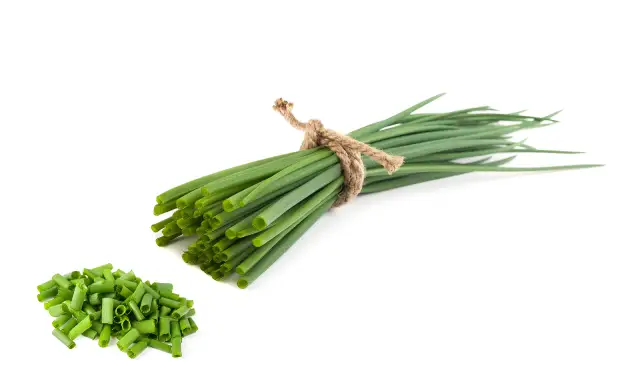
Chives, a popular allium vegetable, are typically used as a herb for flavoring food. This is because they contribute a mild but very flavorful taste to dishes, without the pungency of garlic or onions.
Scientifically, they go by the name of Allium schoenoprasum (27).
A typical serving of chives is a 3-gram tablespoon, and it offers the following nutritional profile (28):
- Calories: 0.9 kcal
- Carbohydrates: 0.13g
- Fiber: 0.08g
- Sugars: 0.06g
- Fat: 0.02g
- Protein: 0.10g
Chives pove to be versatile in a wide range of recipes. For some ideas, they make a flavorful addition to dips, egg-based dishes, rice and pasta dishes, sauces and salad dressings, as well as potato salad.
Garlic
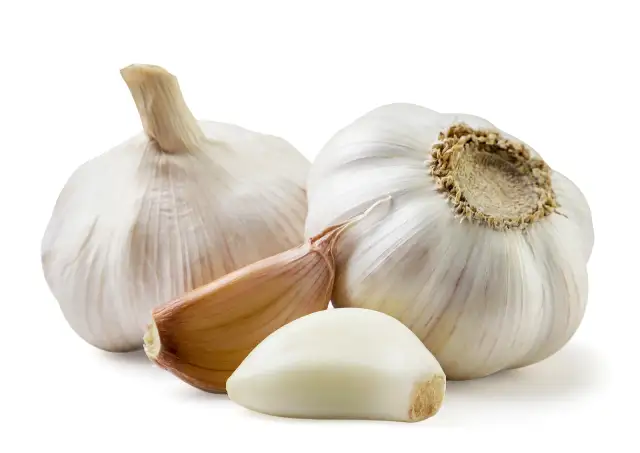
Garlic, an allium vegetable known for its pungency yet remarkably flavorful nature, is popular in cuisines around the world. It has a robust flavor that can leave an aftertaste long after eating. Garlic-based foods can be quite divisive; many people love them, but some dislike the flavor.
The scientific name of garlic is Allium sativum (29).
A common serving of garlic is approximately three cloves, totaling 9 grams, which offers the following nutritional values (30):
- Calories: 13.4 kcal
- Carbohydrates: 2.98g
- Fiber: 0.19g
- Sugars: 0.09g
- Fat: 0.05g
- Protein: 0.57g
Garlic imparts an excellent depth of flavor to various dishes, making it a valuable addition to curries, soups, and stews.
Moreover, it is also a popular ingredient in stir-fries, pasta dishes, sauces, and marinades. Garlic bread is also a popular side dish.
Leeks

Leeks boast a flavor reminiscent of some other allium vegetables, such as garlic and onion, albeit considerably milder. They are also slightly sweet and their mildness makes them an ideal addition to a wide range of recipes without being overpowering.
Scientifically, leeks are known as Allium porrum (31).
An 85-gram serving of cooked leek offers the following nutritional composition (32):
- Calories: 74.8 kcal
- Carbohydrates: 12.5g
- Fiber: 1.62g
- Sugars: 3.46g
- Fat: 2.59g
- Protein: 1.34g
Among the various culinary applications for leeks, they work especially well in soups, stews, and omelets.
For a comprehensive nutritional guide to leeks, please refer to the article below:
Leeks: Nutrition Facts and Potential Health Benefits
Onions
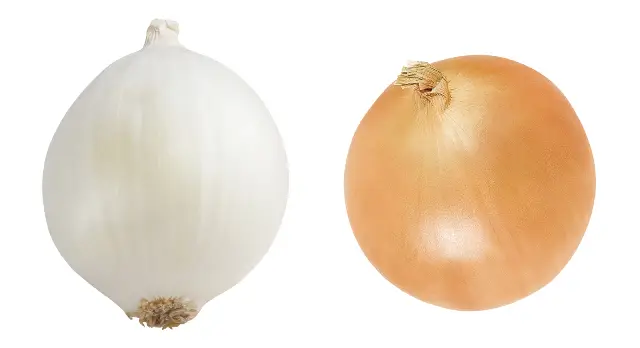
Onions rank as the most popular allium vegetable, being the most extensively cultivated allium species. The scientific name of the onion is Allium cepa (33).
This popular vegetable is a staple in diets around the world. While raw onions deliver a strong and pungent taste, they develop a milder, sweeter flavor when cooked.
A medium onion, weighing approximately 94 grams when cooked, offers the following nutritional properties (34):
- Calories: 41.4 kcal
- Carbohydrates: 9.59g
- Fiber: 1.32g
- Sugars: 4.45g
- Fat: 0.18g
- Protein: 1.28g
Onions are a prominent ingredient in stir-fries, thanks to their crisp texture and rich flavor profile. They can also be eaten sauteed as a side vegetable or employed as a flavor enhancer in curries, sauces, soups, and stews.
Rakkyo
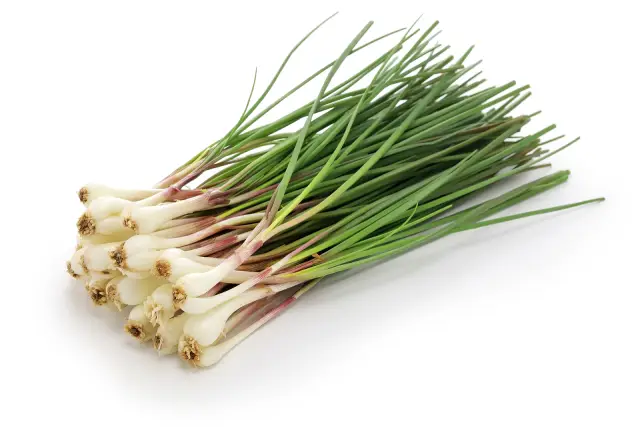
Rakkyo is perhaps the least recognized among the common edible allium vegetables. However, this depends, although its popularity can vary depending on where one lives, with Japan and East Asia being particularly fond of it.
So, what exactly is rakkyo? It’s like a small shallot that is then pickled and, in Japan, it graces the table as a side dish alongside many dishes.
Rakkyo is also known as ‘Japanese scallion’ and it has the scientific name of Allium chinense (35).
As it is usually served pickled, rakkyo has a slightly tangy taste. It also offers a hint of sweetness and a big crunchy texture.
Although the typical serving size is quite modest (just a few pieces), we’ll provide the the nutritional properties of rakkyo per 100 grams (3.5oz) (36):
- Calories: 91 kcal
- Carbohydrates: 22.9g
- Fiber: –
- Sugars: –
- Fat: 0.1g
- Protein: 0.8g
Locating rakkyo in general grocery stores can be challenging. However, it should be available for purchase in Asian grocery stores or anywhere that sells Japanese food.
Scallions
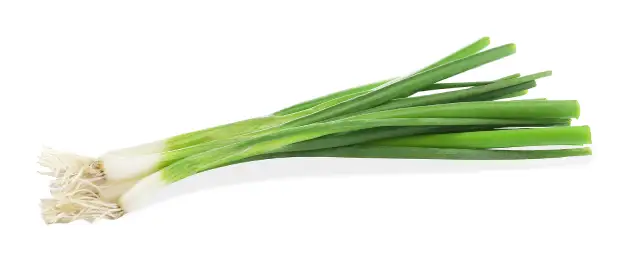
Depending on your location in the world, scallions may also go by the name of green onions or spring onions.
Scallions are actually, in fact, a type of onion with an underdeveloped bulb. They have a far sweeter and milder taste compared to regular onions.
Scientifically, scallions are identified as Allium fistulosum (37).
A typical cooked 15-gram scallion presents the following nutritional profile (38):
- Calories: 9.5 kcal
- Carbohydrates: 1.26g
- Fiber: 0.45g
- Sugars: -0.40g
- Fat: 0.48g
- Protein: 0.31g
Much like leeks, scallions complement a variety of dishes with their mild and slightly sweet flavor. Notably, they excel in stir-fries, rice and noodle-based dishes, and for adding flavor to omelets.
Shallots
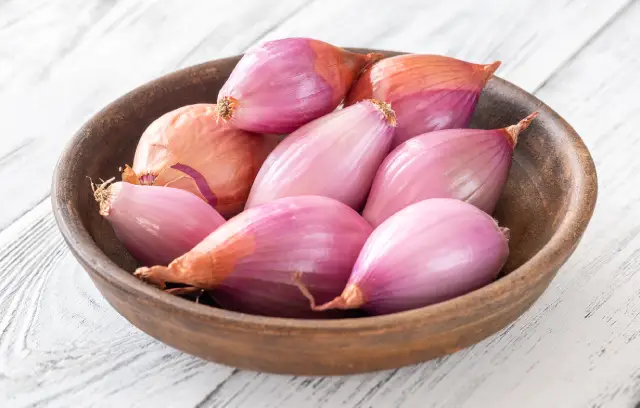
Shallots look like onions but with an elongated bulb, but with their own distinct flavor. This interesting allium vegetable offers a milder and considerably sweeter taste than onions. Overall, they possess a complex flavor that tastes a little like onions and a bit like garlic, but unique from both.
The scientific name of shallots is Allium cepa gr. aggregatum (39).
Per 100-gram (3.5-ounce), shallots provide the following nutritional composition (40):
- Calories: 72 kcal
- Carbohydrates: 16.8g
- Fiber: 3.2g
- Sugars: 7.87g
- Fat: 0.1g
- Protein: 2.5g
Shallots are famous for their deep flavor and feature in many gourmet foods. Valued by chefs, they can be used in a similar way to onions and leeks, adding a great depth of flavor to dishes.
Do Allium Vegetables Have Any Downsides?
Like any food group, allium vegetables come with context-dependent potential drawbacks.
- FODMAPS: Allium vegetables can be high in fermentable oligosaccharides, disaccharides, monosaccharides, and polyols (FODMAPS) (41). FODMAPS can trigger digestive symptoms in some individuals, and low-FODMAP diets can potentially improve symptoms of digestive distress and irritable bowel syndrome (42). Therefore, allium vegetables may not align with a low-FODMAP diet (43). Individuals experiencing digestive issues should consult their physician or a registered dietitian for guidance.
- Allergies: Although allergies to allium vegetables are rare, they do exist. In certain cases, foods like garlic and onions have induced allergy symptoms and, in some cases, even anaphylaxis (a severe allergic reaction) (44, 45). Anyone suspecting an allergy to allium vegetables should seek guidance from their physician or a trusted health professional.
- Medical interactions: garlic and onions can interact with certain medications, such as anticoagulant drugs (46, 47). Once again, individuals using such medications should confer with their healthcare team.
Final Thoughts
In summary, allium vegetables can deliver delicious flavor and excellent nutritional value to one’s diet.
The interesting compounds they contain, like organosulfur compounds, may also offer a range of health-protective effects.

